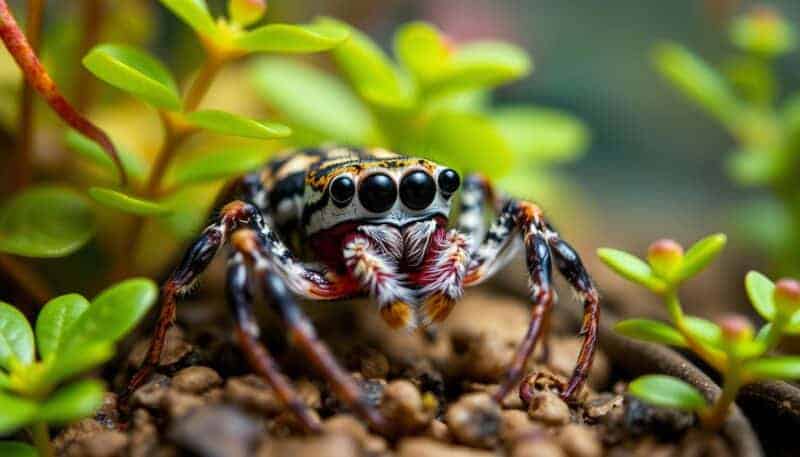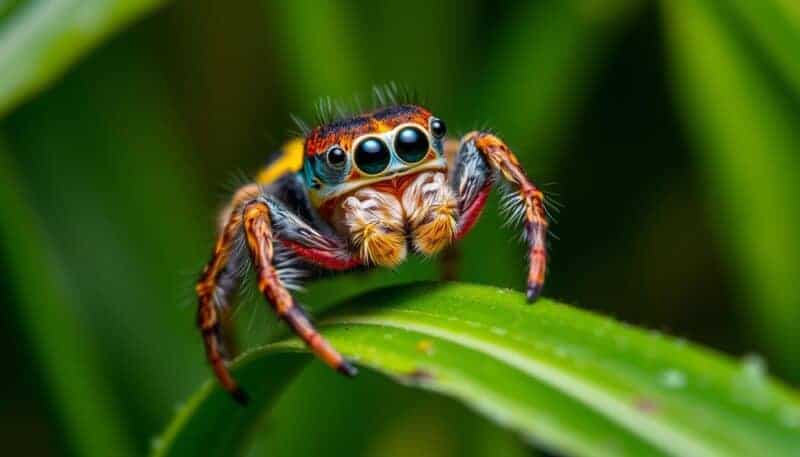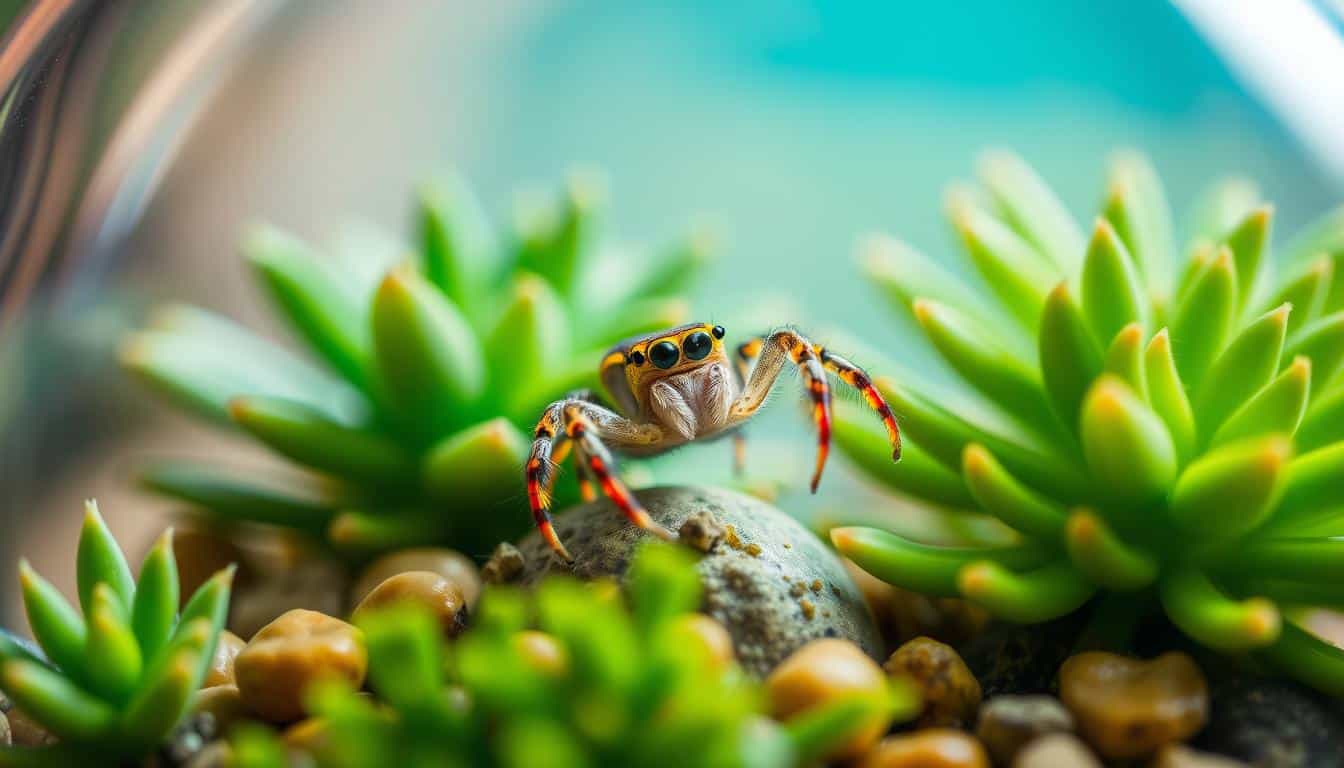Introduction
Understanding Jumping Spiders as Pets
Benefits of Keeping Jumping Spiders
Common Misconceptions About Spider Pets
Legal Considerations for Spider Ownership
“Jumping spiders are remarkable creatures, captivating us with their unique behavior and intelligence. As pets, they offer a window into a world that is often misunderstood, fostering a greater appreciation for the natural world around us.”
Popular Jumping Spider Species for Beginners
Phidippus audax
Phidippus regius
Salticus scenicus
Essential Housing Requirements
Creating the right home is key for your jumping spider’s health. You need to think about the size and type of enclosure, the substrate, and how to control the temperature. Each part of the habitat is important for your spider’s happiness and health.
Enclosure Size and Type
The enclosure should be big enough for your spider to explore, hunt, and build webs. It should be at least 4 to 6 times the spider’s leg span. Terrariums with secure lids are great because they offer lots of space and keep the right humidity and temperature.
Substrate and Decorations
For the substrate, a mix of coco fiber and sphagnum moss is good. It keeps moisture and looks natural. Add decorations like branches, rocks, and fake plants to make the habitat interesting and fun for your spider.
Temperature and Humidity Control
Jumping spiders like it warm and humid. Keep the temperature between 70-80°F (21-27°C) and the humidity at 60-80%. Use heaters and fans to keep your spider comfortable and healthy.
| Enclosure Type | Recommended Size | Substrate | Temperature | Humidity |
|---|---|---|---|---|
| Terrarium | 4-6 times the spider’s leg span | Coco fiber and sphagnum moss | 70-80°F (21-27°C) | 60-80% |
By setting up the right jumping spider enclosure and jumping spider care, you can make a great home for your spider. It will have a place to explore, hunt, and live happily.
Daily Care and Maintenance Routine
Keeping your jumping spider healthy means following a daily care routine. A regular schedule helps keep their home clean and comfy. Here’s what you should do each day to care for your jumping spider.
Spot Cleaning and Water Misting
Start by checking the enclosure for any mess. Use clean tools to pick up uneaten food and poop. Then, mist the area with dechlorinated water. This keeps the humidity right and gives your spider a drink.
Enclosure Maintenance
- Check the temperature and humidity levels in the enclosure, making adjustments as needed to maintain the optimal range.
- Ensure the substrate remains dry and clean, replacing it if it becomes heavily soiled or damp.
- Inspect the decor and hiding spots, rearranging them if necessary to provide enrichment and stimulation for your jumping spider.
By sticking to this routine, you’ll keep your spider’s home clean and comfy. This helps them stay healthy and happy.
| Daily Care Task | Purpose |
|---|---|
| Spot Cleaning | Removing uneaten prey, fecal matter, and other debris to maintain a clean and healthy environment. |
| Water Misting | Providing a source of clean drinking water and maintaining appropriate humidity levels. |
| Temperature and Humidity Monitoring | Ensuring the enclosure’s environmental conditions remain within the optimal range for your jumping spider. |
| Substrate Maintenance | Keeping the substrate dry and clean to prevent mold or bacteria growth. |
| Decor Rearrangement | Providing enrichment and stimulation for your jumping spider by changing up their habitat. |
Having a daily routine is key to your spider’s health. By following these steps, you’ll make sure their home is perfect for them. This will keep them happy and healthy for a long time.
Feeding Your Jumping Spider
Feeding your jumping spider is key to its care. These fascinating arachnids need specific food to stay healthy. We’ll explore how to feed jumping spiders right.
Types of Suitable Prey
Jumping spiders eat a variety of prey. Good choices include:
- Crickets
- Mealworms
- Fruit flies
- Small roaches
- Springtails
Make sure the prey is the right size for your spider. Too big can hurt them.
Feeding Schedule
The jumping spider care feeding schedule varies by age and size. Here’s a general guide:
- Slings (baby spiders): Feed every 3-5 days
- Juveniles: Feed every 5-7 days
- Adults: Feed every 7-10 days
Watch your spider’s hunger and adjust feeding times. Each spider is different.
Prey Size Guidelines
| Spider Size | Prey Size |
|---|---|
| Slings | 1/4 to 1/2 the size of the spider’s body |
| Juveniles | 1/2 to 3/4 the size of the spider’s body |
| Adults | Up to the size of the spider’s body |
Stick to these guidelines for the right nutrition. This prevents injury and stress.
“Proper feeding is essential for the health and longevity of jumping spiders in captivity.”
Health and Wellness Monitoring
Keeping your jumping spider healthy is crucial. Watch for any signs of illness early. This way, you can take action quickly to help your spider.
Recognizing Healthy Jumping Spiders
A healthy jumping spider shows certain signs:
- Bright, alert eyes with no cloudiness or discoloration
- Smooth, unblemished exoskeleton without any cracks or discoloration
- Brisk, coordinated movements and a lively, curious demeanor
- Consistent appetite and interest in feeding
- Regular molting and growth cycles
Common Health Concerns for Jumping Spiders
Jumping spiders can face health issues. Watch out for:
- Respiratory infections, which can cause labored breathing or lethargy
- Dehydration, which may manifest as a wrinkled or dull exoskeleton
- Parasitic infections, which can lead to weight loss or unusual behavior
- Injuries from falls or aggressive interactions with prey
Preventative Care Measures
To keep your spider healthy, take these steps:
- Maintain a clean, well-ventilated enclosure with appropriate temperature and humidity levels
- Provide a varied, nutritious diet with properly sized prey items
- Observe your spider’s behavior and physical appearance for any changes or concerns
- Consult with an exotic animal veterinarian for regular check-ups and guidance
By being proactive, your jumping spider can live a long, happy life.
| Common Health Concerns | Symptoms | Recommended Action |
|---|---|---|
| Respiratory Infection | Labored breathing, lethargy | Seek veterinary treatment immediately |
| Dehydration | Wrinkled, dull exoskeleton | Increase humidity, provide water source |
| Parasitic Infection | Weight loss, unusual behavior | Consult veterinarian for proper diagnosis and treatment |
| Injuries | Visible wounds, limb damage | Isolate spider, seek veterinary care |

“Maintaining the health and well-being of your jumping spider should be a top priority. Regular monitoring and preventative care can go a long way in ensuring your pet’s longevity and quality of life.”
Safe Handling Techniques
Keeping jumping spiders as pets requires learning safe handling. These arachnids may look delicate, but with the right approach, you can enjoy their company. This is without risking their wellbeing or yours.
Building Trust with Your Spider
Building a positive relationship with your jumping spider is key. Use slow, gentle movements and regular, patient interaction. Avoid sudden actions or loud noises, as they can startle and distress the spider.
Signs of Stress to Watch For
- Raised legs or “defensive” posture
- Rapid movements or attempts to flee
- Tapping or “drumming” motions with their legs
- Refusing to accept food or hiding for extended periods
If you see these stress signals, stop handling and give your spider time to recover. Respecting their boundaries is crucial for their trust and health.
Emergency Handling Situations
In emergencies, like removing from an unsafe place or vet care, calm handling is vital. Gently scoop the spider into a container or grasp it around the thorax. Be careful not to restrict its movements or apply too much pressure.
Jumping spiders are fascinating creatures that deserve our respect and care. By learning safe handling, you can have a rewarding experience as a responsible owner.
Breeding and Lifecycle Information
The world of jumping spider reproduction, you will discover their complicated mating behaviors and lifecycle. These spiders have unique courtship rituals and care for their egg sacs meticulously. Understanding their breeding process is key to keeping them as pets.
In jumping spider breeding, males perform an impressive dance to attract females. Once a female is ready, they mate. The female then builds an egg sac for her young. As the spiderlings grow, each stage is filled with unique traits and behaviors.
The lifespan of a jumping spider varies by species, with some living up to a year or more. Proper housing, nutrition, and environment are crucial for their longevity. Knowing their lifecycle helps pet owners care for them better, ensuring they thrive in captivity.
| Jumping Spider Species | Average Lifespan |
|---|---|
| Phidippus audax (Bold Jumping Spider) | 1-2 years |
| Platycryptus undatus (Tan Jumping Spider) | 6-12 months |
| Salticus scenicus (Common Zebra Spider) | 9-18 months |
By exploring jumping spider breeding and lifespan, pet owners can appreciate these arachnids more. They can then provide the best care for them to thrive in captivity.

Conclusion
Keeping jumping spiders as pets is both exciting and rewarding. They show us the amazing world of spiders. We see their incredible jumping and clever hunting ways.
When you start owning a jumping spider, do your homework. Learn what your spider needs. Good care means a happy and healthy pet.
Jumping spiders can be a great choice for anyone. They bring joy and beauty into your home. With love and care, you’ll enjoy a special bond with your spider.
FAQ:
Does a jumping spider make a good pet?
Jumping spiders as pets make excellent companions for those seeking unique and low-maintenance creatures. Their curious personalities, remarkable agility, and ease of care make them fascinating to observe. With minimal requirements, such as a small enclosure and live prey, jumping spiders as pets are ideal for both beginners and experienced enthusiasts.
What is the lifespan of a jumping spider?
Jumping spiders as pets typically have a lifespan of one to two years, depending on their species and care. Proper nutrition, a clean habitat, and a stress-free environment can enhance their longevity. While their time is short, jumping spiders as pets offer engaging and rewarding companionship throughout their fascinating lives.
Can you tame a jumping spider?
Taming jumping spiders as pets is possible through consistent and gentle interaction. These intelligent arachnids can grow accustomed to their owner’s presence, recognizing movements and exploring hands without fear. While they remain independent by nature, jumping spiders as pets can develop a unique sense of trust, making them delightful companions to observe and handle.
Is it okay to hold a jumping spider?
It is generally safe to hold jumping spiders as pets, provided you handle them gently and with care. These delicate creatures can explore your hand, showcasing their curiosity. However, always ensure a calm environment to avoid startling them. Handling jumping spiders as pets responsibly strengthens trust and enhances your bond.
What is the friendliest spider?
Among arachnids, jumping spiders as pets are often considered the friendliest. Known for their curious nature and non-aggressive demeanor, these tiny explorers actively interact with their environment and even their owners. Their approachable behavior and engaging movements make jumping spiders as pets a delightful choice for enthusiasts seeking a unique companion.
Can you bond with jumping spiders?
Jumping spiders as pets can form a unique bond with their keepers through consistent interaction. These curious arachnids may recognize their owners, responding to movements and even exploring hands. While the bond differs from traditional pets, keeping jumping spiders as pets fosters mutual trust, creating a rewarding and fascinating companionship.
How intelligent are jumping spiders?
Jumping spiders as pets are surprisingly intelligent for their size. They exhibit advanced problem-solving skills, excellent vision, and the ability to plan intricate hunting strategies. Unlike many arachnids, they can recognize patterns and even differentiate between objects, making jumping spiders as pets both fascinating and engaging companions for arachnid enthusiasts.
How often do you feed jumping spiders?
When keeping jumping spiders as pets, feeding them every two to three days is ideal. Offer live prey such as fruit flies or small crickets to suit their size. Avoid overfeeding, as these agile hunters require moderation. Caring for jumping spiders as pets includes observing their behavior to adjust feeding schedules.
Share your thoughts in the comments below! If you enjoyed this post, consider subscribing to our newsletter for more pet tips, stories and blogs!

